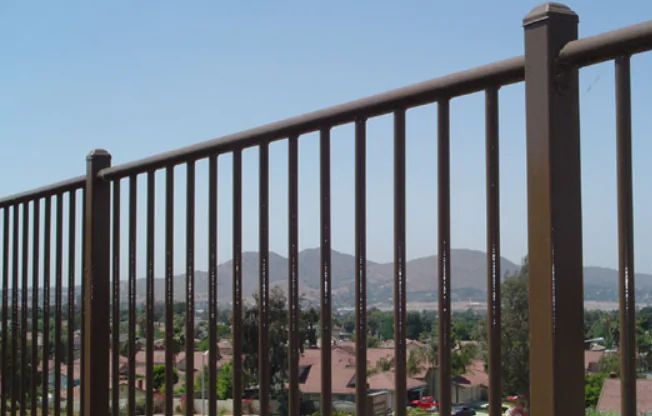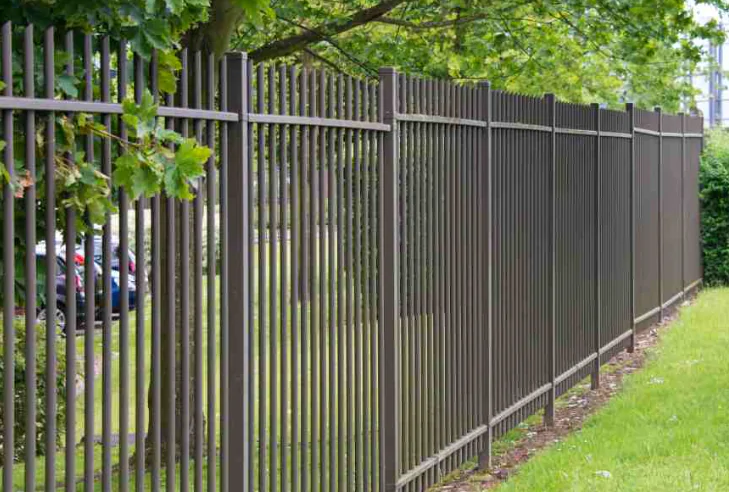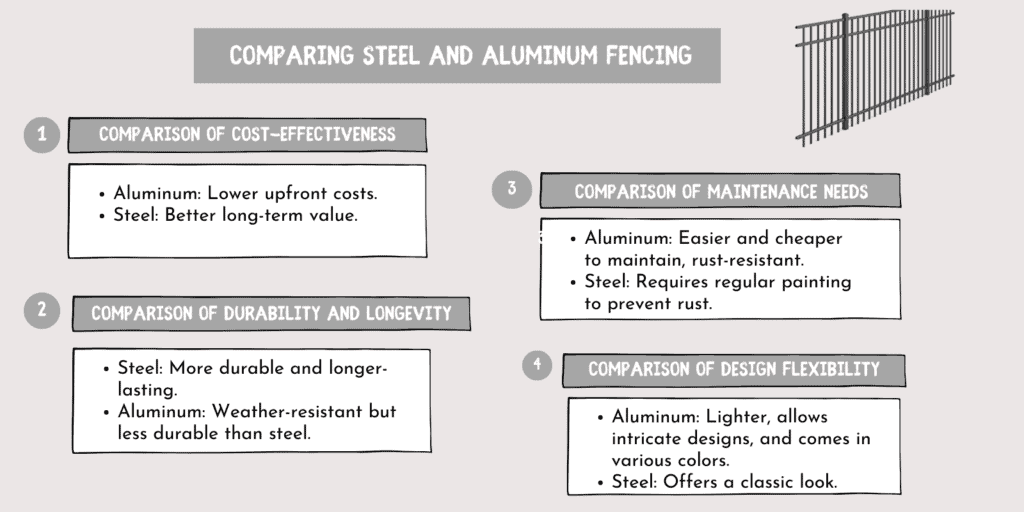Need help with a lack of privacy and security concerns in your home? Worried about the safety of your property? Tubular fencing can be an effective solution to these problems. It not only enhances the aesthetic appeal of your property but also significantly contributes to its security.
Having introduced the concept of tubular fencing, let’s narrow down the discussion to the two most popular choices: steel and aluminum. Both these options offer a reliable, durable, and cost-effective way of boosting home security while maintaining the aesthetic value of your property.
Stay with us as we delve deeper into the benefits of each material, helping you make an informed decision that best serves your security and design preferences.
Understanding Steel Tubular Fencing

A. Overview of Steel as a Material
Steel stands out for its durability and strength. It is a robust alloy primarily composed of iron, which grants it remarkable hardness and resistance to wear and tear. Steel’s durability is enhanced by the fact it resists corrosion, extending its lifespan significantly compared to other materials.
Furthermore, its tensile strength is unmatched, enabling it to withstand high pressures without deformation making it an ideal choice for various construction and fabrication, including steel tubular fencing.
B. Benefits and Downsides of Using Steel for Tubular Fencing
Steel tubular fencing brings several advantages to the table. Firstly, they are incredibly robust and resilient, making them virtually indestructible under everyday circumstances. Hence, they provide a secure boundary and a strong deterrent to intruders.
Secondly, steel tube fences have a unique aesthetic appeal. They can be painted or powder coated in any color, allowing you to tailor their look to your property’s design. Furthermore, they are versatile and can be customized to various heights and designs to match your needs. Lastly, steel fences are resistant to pests, fire, and decay, making them a low-maintenance option compared to wood or other materials.
Even with its extensive benefits, steel tubular fencing has drawbacks. One of the key things I have noted over time is that it is more expensive than other available options. However, given its durability, this upfront investment can pay off long-term.
Also, while it’s corrosion-resistant, certain environmental conditions like saltwater, can cause rust without proper treatment. So, in some situations, it may require a bit more maintenance to keep it in optimum condition.
| Benefits ✅ | Downsides ❎ |
| High strength and durability Suitable for high-security areas Resistant to harsh weather conditions Aesthetically pleasing Ideal for residential properties and open spaces Offers great life-long value and versatility | More expensive Require more maintenance |
C. Best Applications for Steel Tubular Fencing
Due to its strength and durability, this fencing is ideal for places that demand high security, such as industrial properties, schools, and houses. It’s also perfect for places prone to harsh weather conditions as it can withstand such elements with minimal damage. Its aesthetic appeal makes it a great fit for residential properties, parks, and open spaces where looks are just as important as function.
The overall life-long value and versatility of steel tubular fencing make it a solid choice. My cumulative knowledge and practical application have led me to believe that while there might be a few cons, the pros far outweigh them, making steel an excellent material for tubular fencing.
Understanding Aluminum Tubular Fencing

A. Overview of Aluminum as a Material
Aluminum has its unique characteristics, advantages, and limitations. Aluminum, in particular, is an appreciable material due to its lightweight nature. This means it is easy to transport, handle, and install. Another notable characteristic of aluminum is its excellent corrosion resistance, even under harsh weather conditions.
B. Benefits and Downsides of Using Aluminum for Tubular Fencing
The advantages of using aluminum for tubular fencing extend far beyond its lightweight nature and resistance to corrosion. This material is also highly adaptable and customizable. It can be easily molded into various shapes and styles to allow for individual customization, a feature that my clients have appreciated on several occasions.
Furthermore, aluminum requires minimal maintenance, and unlike wood, it is not susceptible to termites or other pests. Lastly, for those mindful of the environment, you’ll be pleased to note that aluminum is sustainable and recyclable.
While aluminum provides several benefits, it’s important to be cognizant of its limitations. Compared to materials such as steel or iron, aluminum is less rigid. This might impact the structural integrity of the fence in extremely high-pressure conditions. Due to its lighter weight, aluminum can be prone to denting, especially in areas with heavy traffic, boisterous pets, or children.
| Benefits ✅ | Downsides ❎ |
| Lightweight nature Resistance to corrosion Highly adaptable and customizable Can be molded into various shapes and styles Requires minimal maintenance Not susceptible to termites or other pests Sustainable and recyclable | Less rigid compared to steel or iron Might have compromised structural integrity under extreme pressure Prone to denting in high-traffic areas or with boisterous pets/children |
C. Best Applications for Aluminum Tubular Fencing
Regarding the optimal application of aluminum tubular fencing, I must emphasize that its versatility is its greatest strength. Its resistance to corrosion makes it perfect for environments with high humidity or heavy rainfall. I have also found it to be an excellent choice for pool fences due to the same reason.
Its lightweight and customizable nature makes it ideal for residential areas where aesthetics matter. However, due to its lower rigidity than materials like steel, I would advise against using it in high-security areas or where higher structural durability is needed.
Comparing Steel and Aluminum Fencing

A. Comparison of cost-effectiveness between the two materials
Both materials have unique cost advantages. While the upfront costs for aluminum fencing tend to be lower due to cheaper material costs and easier installation, steel fencing offers excellent long-term value. Its durability means it won’t need to be replaced for many years, making it a potentially economical choice for homeowners who intend to stay in their homes for a long time.
B. Comparison of durability and longevity
Steel is typically more durable while both materials are resistant to weather conditions. Unlike aluminum, it can withstand significant weight and impact without bending or breaking. Consequently, steel fencing may outlast aluminum, providing homeowners with long-lasting value, especially in harsh weather conditions that may otherwise damage aluminum fences.
C. Comparison of maintenance needs – painting, rust prevention, etc.
Steel and aluminum require some degree of upkeep. However, aluminum is generally easier and less expensive to maintain. It resists rust and corrosion, eliminating the need for frequent rust-prevention treatments. On the other hand, steel requires regular painting or coating to prevent rust and maintain its appearance. Be that as it may, with proper maintenance, both fences can retain their aesthetic appeal for years.
D. Comparison of design flexibility
Steel and aluminum offer great design flexibility. Aluminum is lighter and easier to manipulate into intricate designs, making it a popular choice for customized fences. It is also available in a broad range of colors, allowing homeowners to match their fence to the style of their home. While less versatile, steel offers a classic, sophisticated aesthetic that some homeowners may prefer.
Factors to Consider when Choosing Between Steel and Aluminum

A. The environment and climate where the fencing will be installed.
Considering these factors is crucial when choosing between steel and aluminum for your fencing. For instance, if you live in an area with heavy humidity or proximity to salt water, you might opt for aluminum, as it doesn’t rust as easily as steel. However, steel might be a more durable option for colder climates with heavy snowfall.
B. The purpose of the fencing – property delineation, security, or aesthetics.
Your fencing’s purpose is another pivotal factor to consider. If you’re looking for a strong, burglar-resistant fencing, steel would be your best bet. However, if the primary goal is aesthetics or property delineation, aluminum could be a more fitting choice with its range of styles and finishes.
C. Available budget for installation and maintenance.
It’s important to consider not only the initial cost of installation but also the long-term maintenance costs. Steel generally has higher initial costs but low maintenance, while aluminum might be cheaper to install but could require more upkeep.
D. Personal preference for looks and feel.
Your personal preference plays a significant role. After all, you’ll be looking at this fence every day. Steel fencing often exudes a robust, traditional feel, while aluminum can be molded to fit a more contemporary design.
Choosing between steel and aluminum fencing requires careful consideration of several factors. It’s crucial to remember that while I can provide guidance based on years of experience and deep knowledge in this field, the final decision heavily depends on your specific situation and preferences. When accurately aligned with your needs, you can trust that either choice will serve as a reliable, long-term investment for your property.
Conclusion
In wrapping up, we’ve delved deep into the intricacies of both steel and aluminum tubular fencing, highlighting their strengths, drawbacks, and best-use scenarios. With its robustness and longevity, steel is ideal for those seeking durability and a timeless aesthetic. On the other hand, aluminum shines in its lightweight nature, resistance to corrosion, and ease of installation.
Both materials have their rightful place in fencing, depending on the specific needs and preferences of the user. As you contemplate the best choice for your project, I’d highly recommend giving this article a thorough read.
It offers a comprehensive comparison that can guide your decision-making process. Remember, the fence you choose is not just a barrier; it’s an investment in your property’s safety, aesthetics, and value. Take the time to choose wisely!


